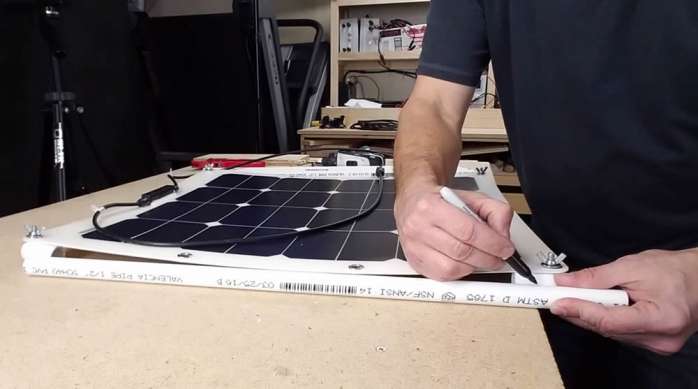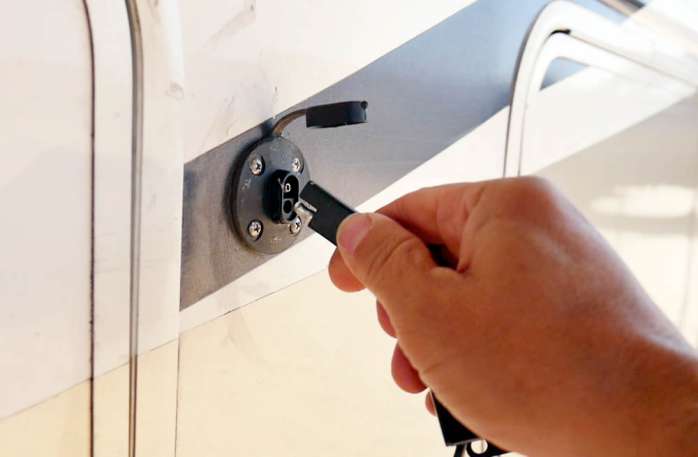Here’s how to build a portable solar panel stand that can double as a window awning to keep your RV cool. This portable solar setup can expand your existing solar system or even become your primary solar charging system if you don’t have one yet.
We primarily boondock in the southwestern desert during the fall and winter months. The sun is lower and shines directly in the windows. So this solution helps provide shade as well as capturing more sunlight when the sun is lower (mornings and late afternoon).
What Type of Solar Panels to Use for an Awning

This was an easy one for me. I decided on semi-flexible solar panels for a number of reasons.
- They are very light weight
- They are thin and easy to store flat
- They are highly efficient and can provide plenty of power
- They come with grommet holes for easy mounting
Additional Materials You’ll Need For This Project
Building the Solar Awning Frame
I decided to use 1/2 inch PVC pipe and fittings for the frame. PVC is very easy to work with (like Tinker Toys for grown ups). The PVC pipe and fittings were purchased at my local hardware store.

Here’s what I needed to make one awning frame:
- 6 x short sections of PVC pipe
- 4 x corner “L” shaped fittings, (one per corner)
- 2 x “T” shaped fittings to attach the legs
- 4 x stainless steel machine screws
- 4 x washers
- 4 x wing nuts
- Roll of VELCRO
I decided to use heavy duty locking suction cups to mount the panel to the RV wall or window. As an avid stand up paddleboarder, I knew about these suction cup gear mounts designed to secure gear to a paddle board. I thought they would work great for this awning project.
Assembling the Frame
- I first drilled holes in the middle of the four “L” shaped corner fittings and attached them with screws to each corner.
- Using the corner fittings as a guide, I measured and cut four lengths of PVC (one for each side) overlapping the each fitting by roughly 3/4″
- I assembled the sides and bottom of the frame by inserting the PVC sections into the corner fittings
- Using two short sections of pipe, and the “T” shaped fittings, I created a hinge point for each of the two legs
- I cut two more PVC lengths for each leg and inserted them into the “T” fittings
- “L” fittings were attached to each leg with another section of PVC to connect the two legs and form a cross brace
- Finally, I cut a PVC section to connect the two “T” fittings at the top of the frame
Before mounting the suction cups to the frame, I first removed the gear hooks leaving the cross brace. Then I connected the suction cups to the top of the frame using VELCRO straps.
Build Videos
I made two versions of these solar awnings to work with the different sized windows on my RV.
Version 1 – Smaller Square Awning
A smaller square-shaped 50 watt solar awning would fit a small or narrow window.
Version 2 – A larger rectangular awning
This larger rectangular-shaped 100 watt solar awning would fit a larger window.
Connecting The Solar Panels and Charge Controller To The RV
To complete this solar charging setup I needed to add a solar charge controller and some quick connectors.

I used two of the smaller solar awnings for my two large tall windows on the RV. The solar charge controller I selected is a small Victron MPPT solar charge controller capable of converting higher voltage inputs. This allowed me to use a series configuration connecting the two panels end-to-end to produce roughly 40 volts at 3.5 amps.
I also needed an extension cable with SAE connections to connect the panels to an external SAE port I installed on the RV.
Using an MC4 to SAE adapter, I connected the output of the solar panels to the SAE cable and RV.
The SAE power port is wired to the positive (+) and negative (-) PV inputs to the Victron MPPT solar charge controller. To complete the system, I wired the output of the solar charge controller directly to the positive (+) and negative (-) terminals on my battery bank.
Final Thoughts
This has been a very useful addition to our boondocking arsenal. Mounting these on our windows have been very effective at keeping the windows cool while pushing more solar energy into our battery bank.
Throughout the afternoon until dusk I adjust the angle on the solar panels to track the sun. In the morning, I angle them back up.
If you give this a try, let me know how it works for you. Good luck!
